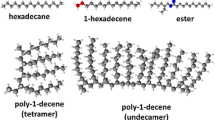Abstract
The structural, mechanical (friction) and spectroscopic properties of model lubricant films made of self-assembled and Langmuir–Blodgett monolayers on quartz, mica and gold have been investigated with atomic force microscopy, the surface forces apparatus and sum-frequency generation. In these films, the molecules tend to form densely packed structures, with the alkane chains mostly vertical and parallel to each other. The SFG results suggest that under moderate pressures of a few tens of MPa, the methyl end group of the alkane chains is rotated to accommodate a terminal gauche distortion. The molecule, however, retains its upright close-packed structure with a lattice periodicity when ordered, which can be resolved by AFM. At pressures above 0.1 GPa, changes in the form of collective molecular tilts take place that lower the height of the monolayer. Only certain angles of tilt are allowed that are explained by the interlocking of methylene units in neighboring chains. The discrete angular tilts are accompanied by increases in friction. A model based on the van der Waals attractive energy between chains is used to explain the stability of the films and to estimate the cohesive energy changes during tilt and, from that, the increases in friction force.
Similar content being viewed by others
References
M. Salmeron, Chemtech 28 (1998) 17.
R.W. Carpick and M. Salmeron, Chem. Rev. 97 (1997) 1163.
A. Ulman, Introduction to Ultrathin Organic Films (Academic Press, Boston, 1991).
B.N.J. Persson, Sliding Friction: Physical Principles and Applications (Springer, Heidelberg, 1998).
Q. Du, E. Freysz and Y.R. Shen, Science 264 (1994) 826.
Q. Du, X.-d. Xiao, D. Charych, F. Wolf, P. Frantz, Y.R. Shen and M. Salmeron, Phys. Rev. B 51 (1995) 7456.
K. Kojio, S. Ge, A. Takahara and T. Kajiyama, Langmuir 14 (1998) 971.
A.B. Tutein, S.J. Stuart and J.A. Harrison, Langmuir 16 (2000) 291.
X.-D. Xiao, J. Hu, D.H. Charych and M. Salmeron, Langmuir 12 (1996) 235.
A. Lio, D.H. Charych and M. Salmeron, J. Phys. Chem. B 101 (1997) 3800.
G.-y. Liu and M. Salmeron, Langmuir 10 (1994) 367.
G.-y. Liu, P. Fenter, C.E.D. Chidsey, D.F. Ogletree, P. Eisenberger and M. Salmeron, J. Chem. Phys. 101 (1994) 4301.
M. Salmeron, G. Neubauer, A. Folch, M. Tomitori, D.F. Ogletree and P. Sautet, Langmuir 9 (1993) 3600.
M. Salmeron, G.-y. Liu and D.F. Ogletree, in: Forces in Scanning Probe Methods, eds. H.-J. Güntherodt, D. Anselmetti and E. Meyer (Kluwer Academic, Dordrecht, 1995) pp. 593–598.
S.A. Joyce, R.C. Thomas, J.E. Houston, T.A. Michalske and R.M. Crooks, Phys. Rev. Lett. 68 (1992) 2790.
E. Barrena, C. Ocal and M. Salmeron, J. Chem. Phys. 111 (1999) 9797.
C. Carraro, O.W. Yauw, M.M. Sung and R. Maboudian, J. Phys. Chem. B 102 (1998) 4441.
M.M. Sung, C. Carraro, O.W. Yauw, Y. Kim and R. Maboudian, J. Phys. Chem. B 104 (2000) 1556.
A.B. Tutein, S.J. Stuart and J.A. Harrison, J. Phys. Chem. B 103 (1999) 11357.
H.I. Kim, T. Koini, T.R. Lee and S. Perry, Langmuir 13 (1997) 7192.
H.I. Kim, M. Graupe, O. Oloba, T. Koini, S. Imaduddin, T.R. Lee and S. Perry, Langmuir 15 (1999) 3179.
A. Lio, C. Morant, D.F. Ogletree and M. Salmeron, J. Phys. Chem. B 101 (1997) 4767.
E. Barrena, S. Kopta, D.F. Ogletree, D.H. Charych and M. Salmeron, Phys. Rev. Lett. 82 (1999) 2880.
E. Barrena, C. Ocal and M. Salmeron, J. Chem. Phys. 113 (2000) 2413.
R. Ackermann, O. Inacker and H. Ringsdorf, Kolloid Z. Z. Polym. 249 (1971) 1118.
M.D. Mowery, S. Kopta, D.F. Ogletree, M. Salmeron and C.E. Evans, Langmuir 15 (1999) 5118.
R.W. Carpick, D.Y. Sasaki and A.R. Burns, Tribol. Lett. 7 (1999) 79.
M. Hartig, L.F. Chi, X.D. Liu and H. Fuchs, Thin Solid Films 327-329 (1998) 262.
A. Würger, Phys. Rev. Lett. 83 (1999) 1696.
S. Kopta, E. Barrena, D.F. Ogletree, D.H. Charych and M. Salmeron, Phys. Rev. Lett. 83 (1999) 1697.
J.N. Israelachvili, Intermolecular and Surface Forces, 2nd Ed. (Academic Press, London, 1992).
Rights and permissions
About this article
Cite this article
Salmeron, M. Generation of defects in model lubricant monolayers and their contribution to energy dissipation in friction. Tribology Letters 10, 69–79 (2001). https://doi.org/10.1023/A:1009026312732
Issue Date:
DOI: https://doi.org/10.1023/A:1009026312732




